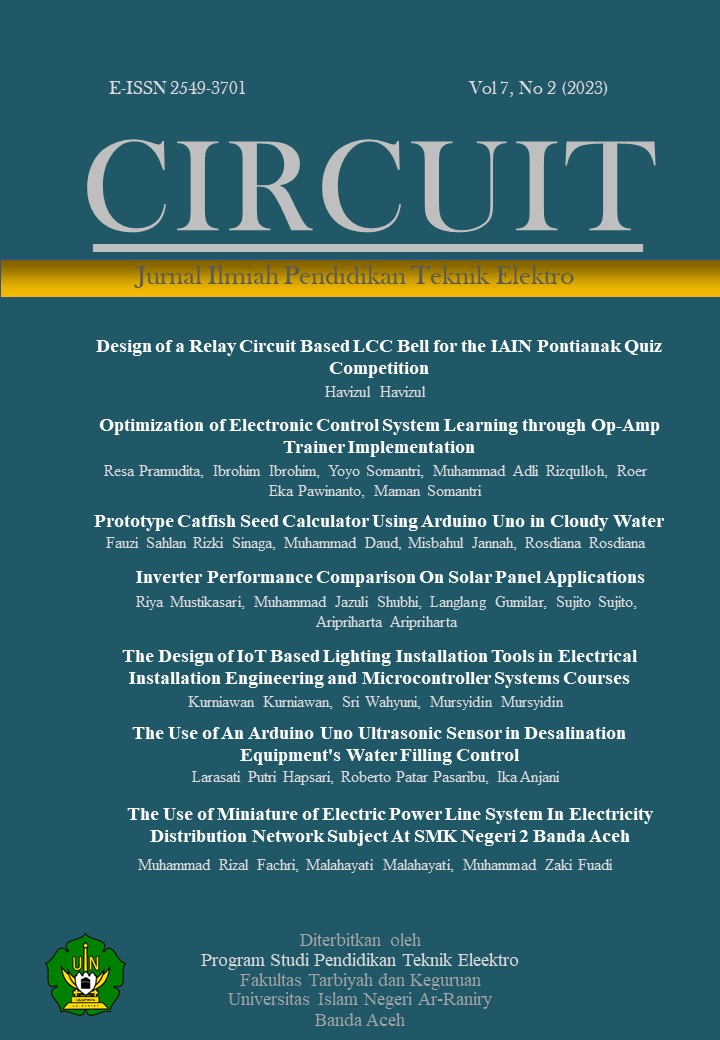Inverter Performance Comparison On Solar Panel Applications
DOI:
https://doi.org/10.22373/crc.v7i2.17631Keywords:
inverter, solar panel, pure sine waveAbstract
In this study, the effects of harmonics on the quality of the electrical power produced by both types of inverters are compared in solar panel applications between pure sine wave and modified sine wave inverters. Additionally, a number of prior investigations into harmonics and inverters have been analyzed. This study was done to find the best kind of inverter to use with solar panels in order to increase the effectiveness and caliber of the electricity generated. Experimental research methodology is applied, with measurements of the electrical power quality produced by both types of inverters under the identical circumstances. According to the findings, the modified sine wave inverter has a higher THD power quality than the pure sine wave inverter. The modified sine wave's displacement power factor (DPF) cannot be more than one (one), but the pure sine wave's DPF is equal to the cos phi value. At a 200W load, the pure sine wave inverter has a power efficiency of 93.35% while the modified sine wave inverter has an efficiency of 81.50%. Given that modified sine waves have a higher harmonic influence, it may be said that pure sine wave inverters create electrical power of a higher quality. Therefore, it is highly advised to utilize a pure sine wave inverter for solar panel applications.
References
Albanna, A. Z., Hatziadoniu J., and Member, S. (2010). Harmonic Modeling of Hysteresis Inverters in Frequency Domain,” vol. 25, no. 5, pp. 1110–1114.
Addiwani, Satria M., Putra, Ananda YW. (2023). Perancangan Rangkaian Forward-Reverse Pada Motor 3 Fasa. Circuit: Jurnal Ilmiah Pendidikan Teknik Elektro, 7(1), p.92-101
Ajeigbe, O., Munda, J., and Hamam, Y. (2018). Characterisation of Harmonic Distortions Produced by Small Domestic Back-Up Generators. IEEE PES/IAS PowerAfrica, PowerAfrica 2018, pp. 432–437, 2018, doi: 10.1109/PowerAfrica.2018.8520981.
Aravind, P. S. and Alexander, S. A. (2013). Harmonic Minimization of a Solar fed Cascaded H Bridge Inverter using Artificial Neural Network, pp. 163–167.
Baitha, A. and Gupta, N. (2015). A comparative analysis of passive filters for power quality improvement,” Proc. IEEE Int. Conf. Technol. Adv. Power Energy, TAP Energy 2015, pp. 327–332, 2015, doi: 10.1109/TAPENERGY.2015.7229640.
Bierk, H., Albakkar, A., and Nowicki, E. (2011). Harmonic reduction in the parallel arrangements of grid-connected voltage source inverters. 2nd Int. Conf. Electr. Power Energy Convers. Syst. EPECS 2011, 2011, doi: 10.1109/EPECS.2011.6126838.
Cheema, M. B., Hasnain, S. A., Ahsan, M. M., Umer, M., and Ahmad, G. (2015). Comparative analysis of SPWM and square wave output filtration based pure sine wave inverters. IEEE 15th Int. Conf. Environ. Electr. Eng. EEEIC 2015 - Conf. Proc., pp. 38–42, 2015, doi: 10.1109/EEEIC.2015.7165289.
Castilla, M., Miret, J., Camacho, A., Matas, J., and De Vicuña, L. G. (2013). Reduction of Current Harmonic Distortion in Inverters via Resonant Current Control, vol. 60, no. 4, pp. 1464–1472
Haider, R., Alam, R., N. Yousuf, B., and Salim, K. M. (2012). Design and construction of single phase pure sine wave inverter for photovoltaic application. Int. Conf. Informatics, Electron. Vision, ICIEV 2012, pp. 190–194, doi: 10.1109/ICIEV.2012.6317332.
Ikhsan, Muhammad., Fachri, Muhammad R. (2023). Power Control Study of Hydrokinetic Power Plants in Presence of Wake Effect. Circuit: Jurnal Ilmiah Pendidikan Teknik Elektro, 7(1), p. 45-53
García-Triviño, P., A. Gil-Mena, J., Llorens-Iborra, F., C. García-Vázquez, A., L. M. Fernández-Ramírez, and Jurado, F. (2015). Power control based on particle swarm optimization of grid-connected inverter for hybrid renewable energy system,” Energy Convers. Manag., vol. 91, pp. 83–92, doi: 10.1016/j.enconman.2014.11.051.
Gumilar, L. (2020). Combination Detuned Reactor and C-Type Filter for Electrical Power System under Harmonic Condition, pp. 219–223
Grady, P. M. and Grady, M. (2012). Understanding Power System Harmonics.
Kwang, T. K. and Masri, S.. (2010). Single phase grid tie inverter for photovoltaic application,” IEEE Conf. Sustain. Util. Dev. Eng. Technol. STUDENT 2010 - Conf. Bookl., no. November, pp. 23–28, 2010, doi: 10.1109/STUDENT.2010.5686988.
M. Dongare. (2017). Mitigation of Lower Order Harmonics in a Grid-Connected Single-Phase PV Inverter using Shunt Active Filter. Int. Conf. Curr. Trends Comput. Electr. Electron. Commun., pp. 192–197.
Phannil, N., Jettanasen, C., and Ngaopitakkul, A. (2017). Power quality analysis of grid connected solar power inverter. IEEE 3rd Int. Futur. Energy Electron. Conf. ECCE Asia, IFEEC - ECCE Asia 2017, pp. 1508–1513, 2017, doi: 10.1109/IFEEC.2017.7992269.
Tiwari, S. K., Singh, B., and Goel, P. K. (2018). Design and Control of Micro-Grid fed by Renewable Energy Generating Sources, 9994(c)), pp. 1–9, 2018, doi: 10.1109/TIA.2018.2793213.
Wang, F., J. Duarte, L., Hendrix, M. A and Ribeiro, P. F. (2011). Modeling and analysis of grid harmonic distortion impact of aggregated DG inverters,” IEEE Trans. Power Electron., vol. 26, no. 3, pp. 786–797, doi: 10.1109/TPEL.2010.2091286.
Young, C., Wu, S., and Liu, Y. (n.d). Implementation of a Multi-level Inverter Based on Selective Harmonic Elimination and Zig-Zag Connected Transformers. pp. 387–392.
Grady, W. M. and Gilleskie, R. J.. (1993). Proc. of the EPRI Power Quality Issues & Opportunities Conference (PQA’93), San Diego, CA, November 1993.,” no. November, pp. 1–8.
Downloads
Published
Issue
Section
License
Authors who publish in CIRCUIT: Jurnal Ilmiah Pendidikan Teknik Elektro agree to the following terms:
- Authors retain copyright and grant the journal right of first publication with the work licensed under a Creative Commons Attribution-ShareAlike 4.0 International License (CC BY-SA 4.0) that allows others to share and adapt the work with an acknowledgement of the authorship and initial publication in this journal
- Authors are able to enter into separate, additional contractual arrangements for the non-exclusive distribution of the journal's published version of the work (e.g., post it to an institutional repository or publish it in a book), with an acknowledgment of its initial publication in this journal.
- Authors are permitted and encouraged to post their work online (e.g., in institutional repositories or on their website) prior to and during the submission process, as it can lead to productive exchanges, as well as earlier and greater citation of published work. (See The Effect of Open Acces)

